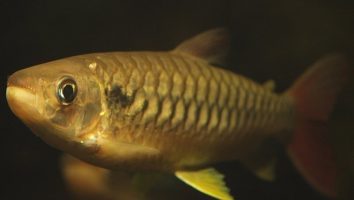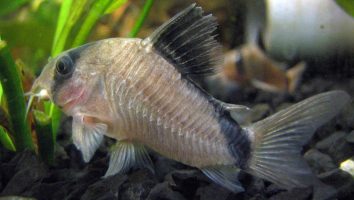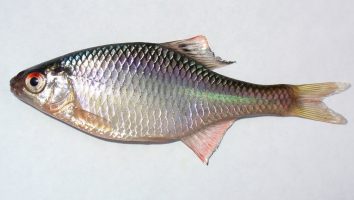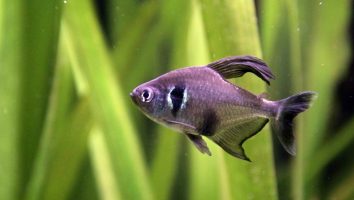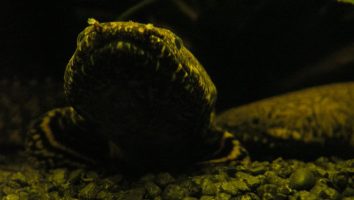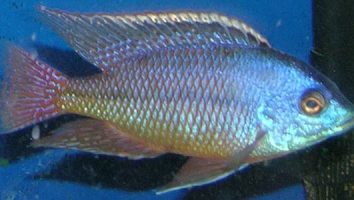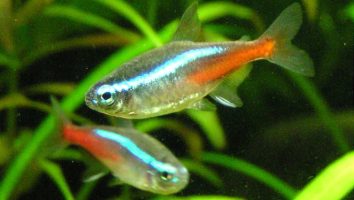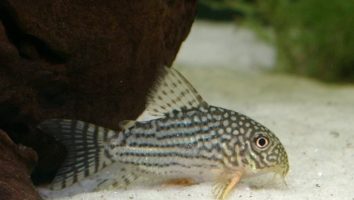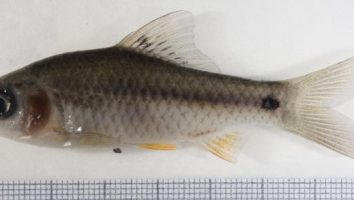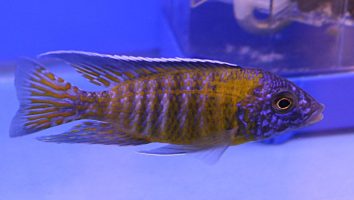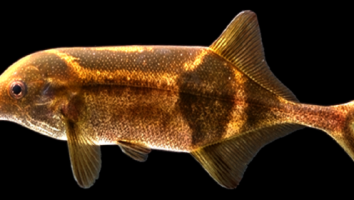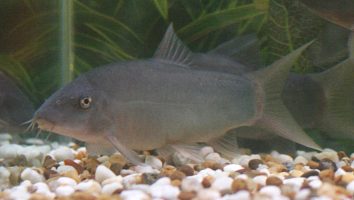The red zebra cichlid is a beautiful freshwater fish that is popular among beginner and experienced aquarists alike.
This guide will teach you everything you need to know about red zebra cichlid care. You’ll learn about their diet, size, lifespan, and more!
Table of contents
Species overview
The red zebra cichlid (scientific name: Metriaclima estherae) is a freshwater fish that’s native to the waters of Lake Malawi in Africa.
They are part of the cichlid family, which is a group of fish known for their vibrant colors and patterns. The red zebra cichlid is no exception, as they are easily recognizable thanks to their red and white stripes.
These fish are relatively peaceful compared to other cichlids, but they can still be aggressive toward their own species. This is why it’s important to have a good ratio of males to females (usually 1:3) if you want to avoid any fighting.
Red zebra cichlids are fairly easy to care for and make a great addition to any freshwater aquarium.
Appearance
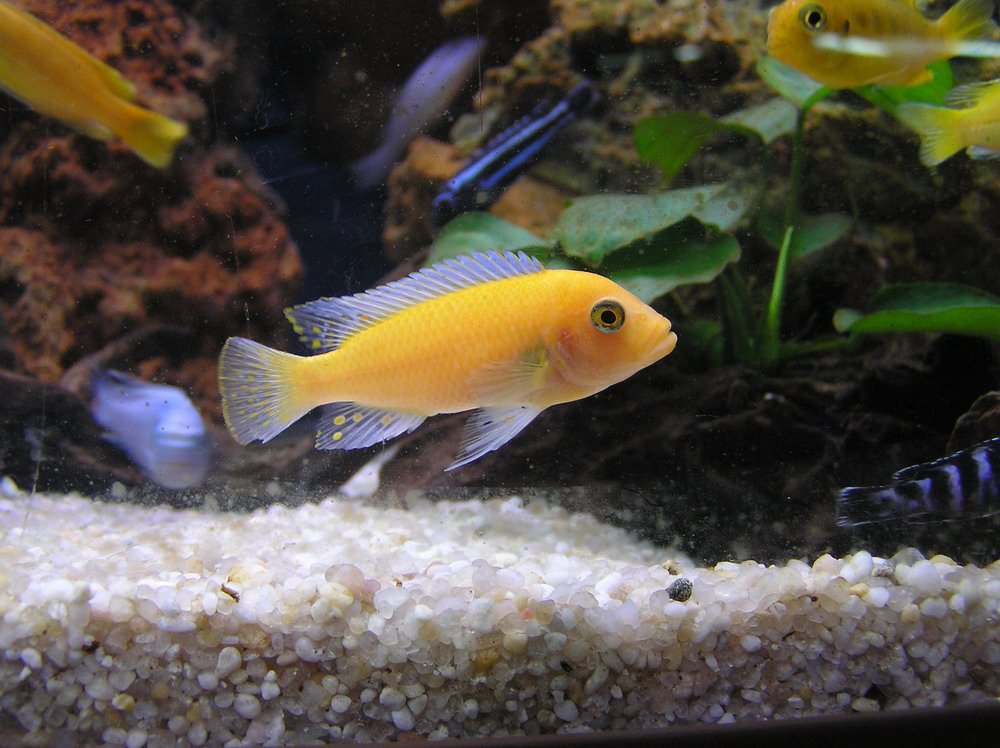
The red zebra cichlid is a beautiful fish that is covered in vertical stripes. The number of stripes on the fish can vary, but there are usually between 10 and 15. The background color of the fish is typically a pale blue, but it can also be white. The stripes are a bright red, which is where the fish gets its name.
The fins of the red zebra cichlid are all red, except for the dorsal fin, which is black. The dorsal fin is tall and triangular in shape. The tail is forked.
The body of the red zebra cichlid is torpedo-shaped. The mouth is large and the teeth are sharp.
Lifespan
The average lifespan of a red zebra cichlid is around 10 years. There are a number of factors that impact their life expectancy.
For starters, if these fish haven’t reproduced then their lifespan will usually be on the higher side of this range. That process can really take a toll on the fish.
The general level of care they receive obviously matters a great deal as well. Even though these are very hardy fish, they’ll obviously live longer in optimal conditions.
Size
The maximum size of a Red zebra cichlid is about 4 inches in length when fully grown. It’s not uncommon for these fish to stop growing at 3 inches depending on their level of care and genetic factors.
Tank
Tank Size
A single red zebra cichlid needs at least a 50-gallon tank. If you plan on keeping more than one, you need to add an additional 40 gallons for each fish. So, a pair of red zebra cichlids would need a 90-gallon tank.
As with most cichlids, these fish are active and love to swim. They will often be found cruising around the tank looking for food or chasing after each other.
Because of their activity level, it’s important to give them plenty of space to move around. A larger tank will also help to reduce the stress levels of these fish and make them less likely to become aggressive.
Water Parameters
Red zebra cichlids are another freshwater fish that come from the East African Rift Lakes. As a result, they have very specific water parameters that you need to maintain.
First and foremost, the water needs to be hard. This is non-negotiable. If the water is too soft, it will strip away the protective slime coat that covers the fish. This makes them vulnerable to infection and disease.
The other water parameter you need to be aware of is alkalinity. This is different from hardness, but both are important. Alkalinity is a measure of the carbonate and bicarbonate in the water.
These two elements help buffer the water and keep the pH stable. Without them, the pH can swing wildly, causing all sorts of problems for your fish.
- Water Temperature: 74 to 82 degrees Fahrenheit
- pH Levels: 8.0 to 9.0
- Water Hardness: 10 to 20 dGH
- Alkalinity Levels: 10 to 30 dKH
What To Put In Their Tank
The first thing you need to do is set up your aquarium with a sandy bottom. These fish love to burrow and will do so frequently.
After the substrate has been taken care of, the next thing on the list is rocks. You want to create a lot of hiding places for your fish since they can be a little skittish.
We recommend using rocks that are smooth and rounded. Anything too pointy can hurt your fish if they happen to bump into it.
Plants are always a great addition to any freshwater aquarium, but they can be a little tricky with cichlids. These fish are known to uproot plants and dig around in the substrate.
If you really want to include plants in their habitat, we recommend using something that’s anchored down well. Java Fern and Anubias are two of the best options.
Last but not least, you should include a piece of driftwood in their tank. This will provide them with a place to hide and give the inside of the aquarium a more natural look.
Common Diseases
The red zebra cichlid is a hardy fish that doesn’t usually fall ill. However, there are still a few diseases that you should be on the lookout for.
The most common disease that affects this species is ich. This is a very common freshwater disease that is caused by a parasite. It’s easily recognizable as it manifests itself as white spots on the body of the fish.
If left untreated, ich can be fatal. However, it’s very easy to treat and most fish will make a full recovery if you act quickly.
The other disease that you might see in your red zebra cichlid is Hole-in-the-Head disease. This is another freshwater disease that is caused by poor water quality.
It manifests itself as, you guessed it, holes in the head of the fish. While it’s not usually fatal, it can be quite serious if left untreated.
As always, the best way to prevent these diseases is to maintain a clean and stable tank. A healthy environment will lead to healthy fish who are less likely to get sick.
Behavior & Temperament
Red zebra cichlids are one of the most popular freshwater fish for aquarists. They’re beautiful, relatively easy to care for, and a lot of fun to watch.
One thing to keep in mind is that these fish are cichlids, which means they can be aggressive. They’re not always the easiest to keep with other fish. If you want to keep them with other fish, make sure they’re of a similar size and temperament.
Red zebra cichlids are also known to be fin nippers. So, if you have fish with long fins, they may not be the best tank mates.
Other than that, these fish are relatively easy to care for. They’re not overly active, but they do like to explore their tanks. They’re also known to be quite shy, so they may not be the best fish for a community tank.
Tank Mates
The question of what tank mates can live with red zebra cichlids is a tricky one.
On the one hand, these fish are relatively peaceful. They’re not known for being overly aggressive towards other fish.
On the other hand, they’re cichlids. And cichlids have a reputation for being fin nippers. They’re also known to be territorial.
The key to success is to choose tank mates that can hold their own. Red zebra cichlids are known to be nippy, but they’re not bullies. They’re also not known for being overly aggressive.
As long as you choose tank mates that can stand up for themselves, you should be fine.
Some good choices include:
- Convict Cichlid
- Jack Dempsey Cichlid
- Firemouth Cichlid
- Oscar Cichlid
- Green Terror Cichlid
- Blood Parrot Cichlid
Breeding
The best way to breed these fish is in a pairs. Keep them in a breeding tank that’s at least 50 gallons. The water should be fairly hard with a pH between 7.8 and 8.6.
To help induce spawning, you can raise the water temperature to 86 degrees Fahrenheit. You can also add a few rocks to the tank for the female to lay her eggs on.
When the female is ready to lay her eggs, she’ll do it on one of the rocks. The male will then fertilize them. Once that’s done, the female will move the eggs to a different spot for safety.
She’ll do this a few times before finally settling on a spot. The eggs will hatch in about three days.
Once they hatch, you can move the fry to a separate tank. Feed them live foods at first, such as brine shrimp or daphnia. As they grow, you can switch to pellets or flakes.
Conclusion
The Red Zebra Cichlid is a great fish for anyone who wants a little bit of everything. They’re beautiful, they’re active, and they’re not too difficult to care for.
Sure, they might not be the easiest fish on the list, but they’re definitely not the hardest either.
Overall, we think they’re a great choice for anyone who’s looking to add a little bit of excitement to their tank.

